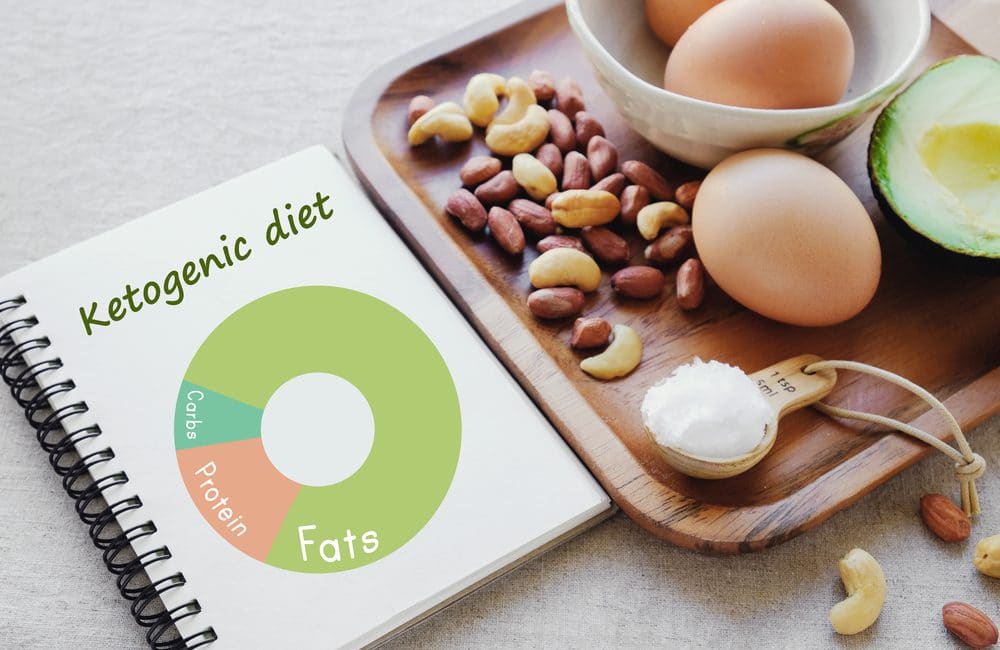The ketogenic diet: the ultimate beginner’s guide to keto

The ketogenic diet is a low-carb diet that has plenty of famous and loyal followers
The ketogenic diet (AKA Keto) is the one diet that has been in the spotlights lately. Over the last few years, it has been exploding in popularity, and according to google trends, the interest of the ketogenic diet has doubled over the previous year alone.
This low-carb, high-fat eating method has plenty of famous and loyal followers.
I spend a lot of time on the internet surfing for latest health news, anti-ageing tips, clean recipes and natural beauty. I also have a keen interest to follow what is going on forums where ketogenic diets are discussed openly.
Unfortunately, it comes to my surprise that the way many people practice a keto diet is somewhat irresponsible. In this article, I would like to discuss how to follow the ketogenic diet safely.
Why I follow the ketogenic diet
What would you say if I told you that the diet I follow allows me to eat more fat, exercise much less and doesn’t make me feel obsessed over calories? You’d probably say I was mad, but that’s probably because you haven’t heard or tried he ketogenic diet. For the last ten years, I’ve gone from overweight, depressed and chronically ill to full of energy and life, happy and confident – and I’ve reached my ideal weight without being on a strict diet that makes you feel depressed.
This was no accident. It took me years to understand that a good diet and eating clean, whole foods was the key to improved health and looks. Hours upon hours of researching and talking with experts has brought me to where I am today.
If you’re struggling with your weight and it’s making you ill and depressed, NOW is the time to take action. You reading this article was no coincidence – it’s something that was destined to be. So sit down, pay attention and most importantly – start taking action!
What is a ketogenic diet?
Put simply, a keto diet drastically reduces carbohydrate intake and replaces carbs with healthy fats. (not just any fat!)
The keto diet combines a high fat, low carb and moderate protein diet that causes the liver to produce ketones. By overproducing these ketones, the body’s metabolism stops using glucose and begins to burns more fat.
This reduction in carbs puts your body into a metabolic state called ketosis.
When we eat food that is high in carbs our body produces glucose and insulin. The insulin regulates our glucose levels in the blood and stores fat, so the more you produce, the more fat gets stored away, leading to weight gain. However, when you follow the keto diet the body’s main source of energy shifts from glucose to fat and ketones. This is why following a diet low in carbs is so essential.
As well as being an excellent tool for weight loss, the keto diet can help improve your overall health and has even been reported to aid Alzheimer’s, Parkinson’s and epilepsy.
What is a Paleo/primal diet?
The primal diet only allows foods that our primal ancestors would have had access too. It eliminates processed foods, grains and most forms of sugars. The primal diet’s focus is on eating healthy fats, more protein and plenty of vegetables, consumed in their most natural way and organic where possible.
I try to stick to the AIP Primal Keto version as much as I can, eliminating all foods that cause inflammation. (such as nightshades, dairy, etc.)
The keto-diet is endorsed by many fit celebrities
Many A-list celebs have also openly endorsed the keto diet and accredited it to their fabulous figures. Actress Halle Berry began following the diet many years ago as a way to help control her diabetes as it helps keep blood glucose levels down. Vanessa Hudgens also started following the keto meal plan to help control her weight. “I think that we’ve been brainwashed to think that fat is bad, but really, it’s what’s going to make you feel fuller longer” she explained at a recent television appearance.
A ketogenic diet is not about ‘zero-carbs.’
Describing the keto diet as no-carbs is far too simplistic. Yes, it promotes a diet low in carbs, but that doesn’t mean you need to cut it out completely. The keto diet, in its essence, is about eating real, wholesome food and adopting a healthier, holistic lifestyle. By following a ‘zero-carb’ approach in the hope that you produce more ketones and are guaranteed weight loss is wrong, and there is no research to back this. The reason why the keto diet has been so successful is due to its appetite-suppressant effects. But also because you can eat well with delicious fats and tasty foods that are satisfying your satiety.
By stabilising your blood sugar and insulin levels, your body begins to release and burn more body fat for fuel. This is a much more reliable and constant source of energy.
Of course, it’s natural to feel hungry when you start any diet and the keto diet is no different. It will take a few days for your body to adapt to this new way of eating and become ‘keto-adapted’, but once it does you will become less dependant on glycogen stores. In the beginning, you could try upping your protein intake as this can help you feel fuller and satiated and whatever you do – don’t try to get full on carbs! Cheat days might sound harmless but it can take days to get your body back to normal. Ask yourself if it’s really worth it?
As time goes on you’ll notice that the keto diet can help you feel fuller for longer and that’s because, unlike a high-carb diet, you stop getting cravings. Hormone levels also become more balanced which can help suppress appetite
The health benefits of a ketogenic diet
As I mentioned before, the keto diet is not a crash or fad diet to help you lose weight quickly – those who follow the keto diet are also following a lifestyle. This is about long-term benefits and long-term weight loss. There are many benefits that come from following it.
A keto diet promotes weight loss
The biggest benefit and the main reason why people follow the keto diet is to lose a lot of weight, quickly. That’s why it’s ideal for those who are overweight or clinically obese. The combination of high fat, low carb can help suppress appetite and aid weight loss.
By eating food low in carbohydrates we release less insulin. Low insulin levels mean that the body won’t store extra energy in the form of fat, and instead is able to reach into existing fat stores for energy.
By consuming more healthy fats you’re also likely to get fuller from eating less.
Prevents type 2 diabetes
Burning more fat may help with weight loss but did you know it can also it also help prevent type 2 diabetes by controlling the release of insulin? When we eat carbs, the body produces a hormone called insulin. Insulin signals our cells to store up energy in our muscles and then eventually as body fat. The ketogenic diet limits our carb intake, which means less insulin is released and blood sugar levels remain normal.
This can help reverse “insulin resistance,” which is a major factor in diabetes and hair loss.
Keto diet helps reduce cholesterol and lowers risk of heart disease
Lowers risk of heart disease Despite being high in fat, the keto diet can reduce cholesterol. In fact, a study found that following the keto diet for 24 weeks resulted in lowered levels of triglycerides, LDL cholesterol and blood glucose.
Protects against cancer
Several studies have found diets high in processed, low-nutrient, high-sugar food can cause cancer cells to proliferate.
An AIP keto diet combats inflammation
The AIP (auto-immune) version of the keto diet helps reduce inflammation. This helps protect our bodies against inflammatory diseases.
Which foods can I eat on a ketogenic diet?
Foods to Eat freely on a keto diet
These foods should be the building blocks of your meal plans.
- Grass-fed meat beef, lamb, goat, pasteurised pork
- Free range poultry
- Wild-caught Fatty fish: Such as salmon, trout, tuna and mackerel
- Free range Eggs: Look for pastured or omega-3 whole eggs
- offal, grass-fed (liver, heart, kidneys, brain and other organ meats)
- saturated fats (lard, tallow, chicken fat, goose fat, clarified butter/ghee, grass-fed butter, coconut oil, beef fat. (I personally eliminate Ghee and Butter as I follow AIP version of Keto)
- polyunsaturated fats omega-3s, especially from animal sources (fatty fish and seafood)
- Monounsaturated fats (avocado, olive oil, macadamia)
- Non-starchy vegetables: celery stalks, bamboo shoots, asparagus, leafy greens (bok choy, spinach, lettuce, chard, chives, endive, swiss chards
- Nightshade plants (don’t eat when following AIP) cucumber, zucchini, tomatoes, onions, peppers
- Condiments: You can use Himalayan salt, pepper and various healthy herbs and spices.
- bone broth
Foods to eat occasionally on a keto diet
These foods should be eaten less frequently but are still an important staple of your Ketogenic diet.
- Root vegetables and tubers: beetroot, sweet potatoes, carrots, parsnips, etc.
- coconut, rhubarb, olives
- berries
- sea vegetables (nori, kombu), okra, bean sprouts, wax beans, French artichokes, water chestnuts
- grain-fed beef, poultry eggs
- dairy products (cottage cheese, sour cream, cream) avoid ALL dairy, if you are like me, following the AIP version of the primal KETO diet.
- sugar and starch-free bacon
- macadamia nuts, pecans, pumpkin seeds, pine nuts, walnuts, hazelnuts, Brazil nuts,
- pistachios, cashews, chestnuts etc
- condiments: monk-fruit, erythritol, arrowroot, xanthan gum (small quantities, in principle this is not Primal friendly)
- extra dark chocolate (no sugar!!) and cacao powder
- sugar-free chewing gum
- nectarine, apple, kiwi, grapefruit, orange, cherries, pears
- dry red and white wine and unsweetened spirits (if you are still in your weight loss phase, it’s better to avoid entirely)
Foods to Avoid on a ketogenic diet
Any food that is high in carbs, grains, gluten and toxins should be avoided entirely
Here is a list of foods that need to be avoided or eliminated on a ketogenic diet:
- Sugary foods: Candy, cookies, soda, fruit juices (also fresh ones, fruit smoothies, cake, ice cream, candy, etc.
- Refined fats (sunflower, safflower, soy, canola, etc
- ALL Grains: eliminate all wheat-based products, rice, pasta, cereal, bread, etc
- Beans or legumes: chickpeas, peas, kidney beans, lentils, etc.
- Low-fat or diet products: eliminate and run away from these highly processed and often high in carbs.
- Unhealthy fats: enjoy freshly made mayonnaise, but eliminate storebought mayonnaise and avoid processed vegetable oils, etc.
- Alcohol: due to their carb content, many alcoholic beverages can throw you out of ketosis. You can occasionally enjoy a glass of wine or unsweetened spirits.
- Sugar-free diet foods: many sugar alternatives are neurotoxic and may cause neurological diseases. These foods also tend to be highly processed. (did you know that there are 257 names for sugar substitutes?)
- Some condiments or sauces: These often contain sugar, gluten, unhealthy fats and other bad ingredients.
- Fruit: try to avoid most fruits except small portions of berries like strawberries and other low glycemic fruits.
- factory farmed park as it’s too high in omega6, the animals are not treated with respect and too many antibiotics
- factory farmed fish
- foods containing carrageenan
- artificial sweeteners (aspartame, acesulfame, sucralose, saccharin) these are all very toxic and produce neurotoxins!
- sweeteners that are affecting blood sugars
- transfats such as margarine kinds of butter
- soy
Keto food-swap guide
In this section you can find some useful ingredients to make your swap-to-keto much easier.
- Xylitol carb-free sugar replacement
- Keto chocolate carb-free chocolate
- Organic monk fruit sweetener sugar free sweetener
- Erythritol carb-free sugar replacement
- Keto coffee
- Keto coffee booster
- Keto bread low-carb bread
- Physillum husk high-fibre ingredient (used to make pancakes, bread, cookies)
- Keto pizza dough guilt-free pizza
- Keto pasta guilt-free pasta
- Keto cookies enjoy guilt-free cookies
- Keto chips
Empowering others via our holistic health books and holistic wellness platform
I hope you like this post about the beginners’ guide to a ketogenic diet. If you would like to learn more about the keto diet ensure to check out our recipes and other pages of this anti-ageing wellness platform.
I changed the way I eat in 2011 when I was diagnosed with hypothyroidism, chronic fatigue and adrenal fatigue, conditions where the thyroid is affected. I had no energy, was exhausted, desperate, and my weight had sky-rocketed.
Because of that, I decided to ditch sugars, processed foods, grains, dairy and toxic chemicals. And step-by-step, I introduced a whole-foods-based (first Paleo) and later an AIP (autoimmune protocol) friendly ketogenic approach to food which gave me my life, vitality, happiness and energy back!
Now, through my holistic wellness books and anti-ageing health platform, I want to empower people around the world do the same and regain their health, hair, life, vitality and beauty!
Let me help you right now!
Receive YOUR Welcome Kit that includes a wide range of topics, from simple and easy healthy brain recipes to clean living, ditching toxic chemicals with loads of practical advice that you can implement immediately
.




